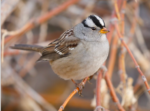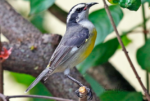We think bird study is one of the best subjects you can take up in a homeschool environment. It’s suitable for all ages, it can be solitary or social, it can be as elementary or as advanced as you wish, and birds can be found just about anywhere at any time of year. And when you’re teaching about birds in the spring and fall in particular, you’ll have an opportunity to introduce your homeschool students to one of the world’s most wonderful natural phenomena: bird migration.
Spring bird migration in the United States (and in other north-temperate regions around the world) begins as early as February for some species, and for others it continues into early June, but the greatest number of species and the greatest number of individual birds head north during late April and May.
One of the best educational resources that you and your students can bookmark and explore all through spring and fall migration is the wonderful BirdCast website, sponsored by Cornell University and other natural science organizations:
- ➢ BirdCast (birdcast.info)
- ➢ BirdCast Nightly Migration Forecasts (birdcast.info)
- ➢ Local Migration Dashboard for Your Region (birdcast.info)
BirdCast provides a “weather” forecast each day during migration season, and the weather it predicts is the nightly level of bird migration across the country. (Did you know that most birds migrate at night? It’s true!)
![[BirdCast]](https://riverhouses.org/wp-content/uploads/2025/04/birdcast-forecast-2021-05-16-1024x576.jpg)
The colors on the BirdCast “weather” maps show the expected intensity of bird migration each night across different U.S. regions: yellow and white are more intense, blue and purple are less intense. Although the seasonal timing of migration is generally governed by the photoperiod (the day-length), local variation in weather conditions can “bottle up” migrants for short periods, resulting in heavy days and light days at any given locality. Gray areas on the forecast maps indicate zones of precipitation that may block migrants from moving forward on a particular night.
One of the most remarkable things available on the BirdCast website is live nightly migration tracking based on nationwide radar networks that see bird movements directly. As sunset moves from east to west across the country, the sky “lights up” with radar echoes of migrating birds — it’s quite dramatic.
![[BirdCast]](https://riverhouses.org/wp-content/uploads/2025/04/birdcast-live-2021-05-08-1024x655.png)
Go to the live migration maps page to see these images in animated form, updated throughout each night during spring and fall migration.
Visit the BirdCast website regularly to help your students connect what they see in your local neighborhood to the grand pattern of migration that is taking place across the whole continent.
What ornithological observations and naturalistical notes have you and your students been making in your homeschool this Leo Term? 😊
❡ Homeschool birds: We think bird study is one of the best subjects you can take up in a homeschool environment. It’s suitable for all ages, it can be solitary or social, it can be as elementary or as advanced as you wish, and birds can be found just about anywhere at any season of the year. Why not track your own homeschool bird observations using the free eBird website sponsored by Cornell University. It’s a great way to learn more about what’s in your local area and about how bird populations change from season to season. 🦅
❡ Books in the running brooks: Our recommended homeschool reference library includes an excellent bird guide that would serve your homeschool well. Many other similar guides are also available — find one that’s a good fit for your family and take it with you on all your outings, whether far afield or just out to the backyard. 🦉
❡ Come, here’s the map: Natural history and geography are deeply interconnected. One of the first questions you should teach your students to ask about any kind of animal or plant is, “What is its range? Where (in the world) does it occur?” Our recommended homeschool reference library also includes an excellent world atlas that will help your students appreciate many aspects of biogeography, the science of the geographical distribution of living things. 🌎
❡ Nature notes: This is one of our regular Homeschool Natural History posts. Add your name to our weekly mailing list and get great homeschool teaching ideas delivered right to your mailbox all through the year. 📫
❡ Homeschool calendars: We have a whole collection of free, printable, educational homeschool calendars and planners available on our main River Houses calendar page. They will help you create a light and easy structure for your homeschool year. Give them a try today! 🗓
❡ Support our work: If you enjoy our educational materials, please support us by starting your regular Amazon shopping from our very own homeschool teaching supplies page. When you click through from our page, any purchase you make earns us a small commission at no extra cost to you. Thank you for helping us to keep going and growing! 🛒
❡ Join us! The aim of the River Houses project is to create a network of friendly local homeschool support groups — local chapters that we call “Houses.” Our first at-large chapter, Headwaters House, is now forming and is open to homeschoolers everywhere. Find out how to become one of our founding members on the Headwaters House membership page. 🏡
![[BirdCast]](https://riverhouses.org/wp-content/uploads/2020/05/birdcast-logo.png)




